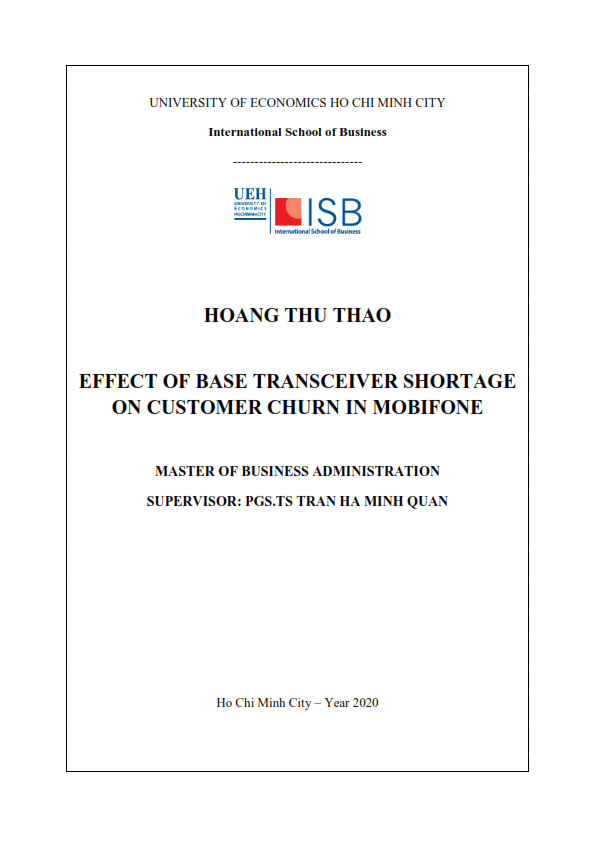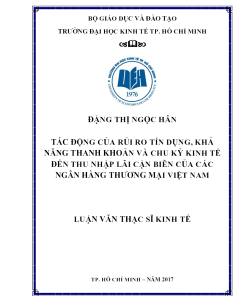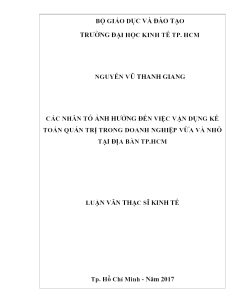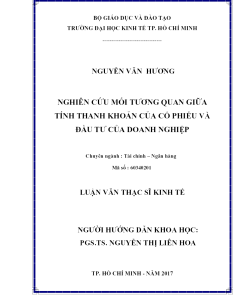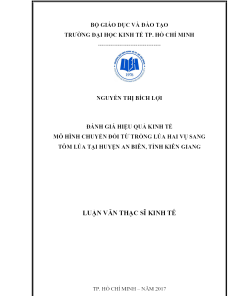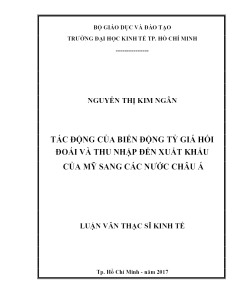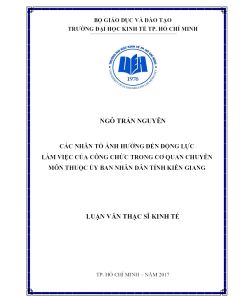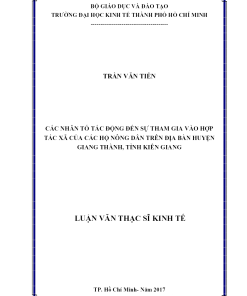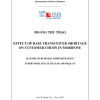Download Master Thesis: Effect of base transceiver shortage on customer churn in Mobifone (ThS01.191)
In 2018, when the Ministry of Culture and Information (MIC) officially launched MNP, the statistics showed that the current number of Mobifone customers has left this provider and switched to using other telecommunication providers such as Viettel, Vina. This rivals obviously have the same situation but with Mobifone, this is an alert for the company to look back on the quality of its service. By making interview, literature review and analyzing the data in 2018-2019. “Service Quality could not adapt Customer needs” is the main problem make customer switch to other providers. The result of research and interview defined 4 causes affected to problem. These causes has been validated and evaluated to define the level of important to company. As the discussion, Lack of base transceiver is the main cause. Based on these causes, alternative solution has been suggested and discussed to find the suitable one for Mobifone. To make clear for the solution, an action plan was made. This action plan is expected to help Mobifone improve their Network Coverage Quality and Service customer.
ThS01.191_Effect of base transceiver shortage on customer churn in Mobifone
Table of contents
1. INTRODUCTION……………………………………………………….2
1.1 Overview of the telecommunication industry in Vietnam…………….2
1.2 Vietnam telecommunication industry challenges from 2013 to 2018...3
1.2.1 Development internet service – 3G/4G……………………..……..4
1.2.2 Network Transfer Services.................................................................5
1.3 Profile of MobiFone Telecom Corporation – Mobifone……………….5
1.3.1 Mobifone organizational structure industry……………………….6
2. PROBLEM ANALYSIS…………………………………………………7
2.1 Mobifone symptom………………………………………………………8
2.2 Initial Cause-effect map………………………………………………....15
2.2.1 Relationship between service quality (SERVIQUAL model) and the first problem…………………………………………………………………....18
2.2.2 Other problems…………………………………………………….. 22
3. PROBLEM IDENTIFICATION………………………………………...22
4. CAUSE VALIDATION…………………………………………………..25
4.1 List of causes………………………………………………...………… .26
4.1.1 Inappropriate telecommunication infrastructure…………… …...26
4.1.2 Poor quality service………………………………………… …....28
4.1.3 Inappropriate pricing……………………………………………….28
4.1.4 Inappropriate competitive strategies ……………………………….31
4.2 Cause evaluation……………………………………………………… ….33
4.2.1 Application of the service quality (SERVIQUAL) model in the telecommunication industry………………………………………………..33
4.2.2 Final caused-effect map…………………………………………….36
5. ALTERNATIVE SOLUTION……………………………………………38
5.1 Priority solutions to BTS shortage……………………………………….38
5.2 Adding solutions to quality of service……………………………………39
5.3 Action Plan………………………………………………………...………41
REFERENCES APPENDIX
Appendix 1: Complaint from Facebook Page of Mobifone (Data collected from
Dec/2018 to Apr/2019)
Appendix 2: Depth interview with internal staffs
Appendix 3: Transcript of Causes evaluation and solution (second interview)
List of Tables
Table 1: Report on the situation of deploying MNP service of the MIC Table 2: Report on the situation of deploying MNP service of the MIC Table 3: Report on the situation of deploying MNP service of the MIC Table 4: Summarized data from the beginning of MNP service
Table 5: Summarized data from the beginning of MNP service
Table 6: Summary of customer feedback on Mobifone service
Table 7: Annual report of total number of BTS of Mobifone from 2005 to 2013
Table 8: The estimated budget forMobifone from Jan to Sep, 2020
List of Figures
Figure 1: Market Share of 3G Data service between providers in 2016
Figure 2: Vietnam data mobile report in Quarter 2, 2017
Figure 3: Mobifone organizational structure, 2017
Firgure 4: Summarized data from 16/11/2018 – 30/10/2019
Figure 5: Report on the situation of New Subscribers during MNP (16/11/2018 –
24/03/2019)
Figure 6: Initial cause-effect map
Figure 7: Conceptual Model of Service Quality Figure 8: The Engel-Blackwell-Miniard Model Figure 9: Updated causes-effect map
Figure 10: Annual report of total number of BTS of Mobifone from 2005 to 2013
Figure 11: Final cause-effect diagram
Abbreviations and Acronyms
ICT Information and communications technologies
MNP Mobile Number Portability QoS Guaranteed quality of service RBV Resource Based View
ROA Return On Return ROE Return On Equity TV Television
VMS Vietnam Mobile Telecom Services Company
VNPT Viet Nam Post and Telecommunication Group
EXECUTIVE SUMMARY
In 2018, when the Ministry of Culture and Information (MIC) officially launched MNP, the statistics showed that the current number of Mobifone customers has left this provider and switched to using other telecommunication providers such as Viettel, Vina. This rivals obviously have the same situation but with Mobifone, this is an alert for the company to look back on the quality of its service. By making interview, literature review and analyzing the data in 2018-2019. “Service Quality could not adapt Customer needs” is the main problem make customer switch to other providers. The result of research and interview defined 4 causes affected to problem. These causes has been validated and evaluated to define the level of important to company. As the discussion, Lack of base transceiver is the main cause. Based on these causes, alternative solution has been suggested and discussed to find the suitable one for Mobifone. To make clear for the solution, an action plan was made. This action plan is expected to help Mobifone improve their Network Coverage Quality and Service
customer.
1
1. INTRODUCTION
1.1 Overview of the telecommunication industry in Vietnam
In the ‘Doi Moi’ economic refomrs that began in 1986, the telecommunications sector in Viet Nam was seen as an essential factor, and the economy achieved a remarkable result through structural reform measures that deviate from the conventional state monopoly mold. Currently, the Vietnam telecommunication industry is dominated by three major service providers, namely, Viet Nam Post and Telecommunication Group (VNPT) – Vinaphone, MobiFone Telecom Corporation – Mobifone, and Army Telecommunications Group – Viettel.
During the first half of 2017, Vietnam’s telecom advertising reported a 127 per cent rise in full profits of 213 trillion dong ($ 9.38 billion), with major commitments from Viettel, with 55 per cent of Vietnam Post and Telecommunications company sales (31 per cent), and Mobifone (9.9 per cent). Telecoms groups announced double-digit revenue growth, supported by supporters switching from 2 G to 3 G services, just as 4
G services recently sent by suppliers. Starting estimates from the Information and Communivations Ministry said that there were around 130 million mobile endorsers as of June, including 68.8 million 2 G customers, 54.2 million 3 G customers and 7.3 millino landline supporters. The sum of wired broadband Network endorses continued growth over the primary half, hitting 10.11 million supporters.
Three major Vietnamese telecommunications groups during the time propelled 4G benefits in large urban communities, and are struggling to convey the nation’s service by the year-end. Driving supplier Viettel said its all-out backers, with 61 million local customers, grew to about 100 million. The gathering declared revenue for the duration approaching 117 trillion dollars, and pre-tax income of 21 trillion dollars, achieving virtually a large portion of its year-round goals.
Worldwide revenue ranged from 25 per cent to $600 million, mostly from flexible adminitrations, particularly 4 G and e-wallet administrations, and huge technology
2
innovation projects for governments and organizations. Viettel is focused on $1.4 billion in overseas sales, a 29 per cent rise year – on – year, and adapting to the target of 50 million endorses in 2017 elsewehere. The organization hopes to finish building network base in Mynmar, and this year will provide 4 G broadband service in its 10 overseas markets1. The outputs of each of the three major players in Vietnam’s telecommunications industry are presented below.
Viet Nam Post and Telecommunication Group (VNPT) - Vinaphone: general sales combined were 53,770 billion VND, reaching 101.2% of the projection, rose 6.3% compared to the year 2016. Besides, the telecommunications and technology revenue reached 48,380 billionVND, up by 6% compared to the last year.
MobiFone Telecom Corporation - Mobifone: MobiFone's recruitment reached 19 million new subscribers, exceeding 1.1% of the projection which was set out in 2017 and 11% growth compared to the year 2016. Revenues reached 38,439 billion VND that was over 107.2% of the year’s projection, growing 14.5% over the year of 2016. Profit before tax in the year 2017 was estimated to reach 5,204 billion, reaching 100% of the target
Army Telecommunications Group - Viettel: Revenues reached 226,558 billion
VND completing 100% of the company target. The net profit before tax reached
43,200 billion VND, achieving the 101% of the projection. Rate of profit before tax/equity 34.1%, complete 100.4% of the plan. In 2017, leading to Viettel's recruitment increase by 7.4 million new subscribers.
1.2 Vietnam telecommunication industry challenges from 2013 to 2018
This section presents the major challenges faced by the Vietnam telecommunication industry between 2013 and 2018.
1 Nikkei Asia (2017). Vietnam telecom market posts strong growth. Asian Review.
3
1.2.1 Development internet service – 3G/4G
Regarding the 3G service market, in 2016, the number of 3G mobile subscribers of Viettel accounted for 57.7% of the total 3G subscribers, an increase of more than 16% compared to 2013. The market share of Vinaphone was 23.9%, an increase of 1.4% compared to 2013. To the contrary, the market share of 3G services of Mobifone reduced from 33.5% in 2013 to 16.1% in 2016. The market shares of the three major
players in the industry are shown in figures 1 and 2 below.
Figure 1: Market Share of 3G Data service between providers in 2016
(Source: White Book of MIC, 2017)
Figure 2: Vietnam data mobile report in Quarter 2, 2017
(Source: Q & Me Vietnam Market Research in 2017)
4
With the new 4G service, Vinaphone, Viettel and Mobifone have not only had an increase in their revenues but have given the users more opportunities to experience unprecedented services in Vietnam. This is not withstanding the many challenges that the Vietnamese providers must overcome, namely: (i) calculating revenue and cost in implement base transceiver of 3G/4G in across the whole country; (ii) developing equipment and tools which will be used for 3G/4G; (iii) price of internet data package (3G/4G); (iv) increasing network and coverage quality.
1.2.2 Network Transfer Services
Mobile Number Portability (MNP) first appeared in some European countries from
2001 to 2004, MNP is a program that enables users to select other mobile network providers without changing Mobile Network Carrier. Accordingly, allowing users to keep the same serial numbers on different mobile network carriers. This service brings many benefits to the users (more choices, better service providers), businesses such as improve service quality and management agencies (garbage scams). MNP seems to create a competitive strength in telecommunications market between providers in which the quality of the service is seen to increase; the value-added products are plentiful and innovative to attract the users, whereas the cost rate of service is seen to decrease. MNP also helps MIC in controlling the number of Sim/ Card. Besides, it brings some opportunities such as attracting customer from other Operators; Reviewing and Evaluating Company Customer care service quality and becoming a service provider rather than a pure network operator. This service implementation at the end of 2018 is seen to be a threat to Mobifone in telecommunication market.
1.3 Profile of MobiFone Telecom Corporation - Mobifone
Formed Vietnam Mobile Telecom Services Company – VMS, Vietnam Post and
Telecommunications Corporation, state owned company, was established on April
16th, 1993. Mobifone has since developed from strength to strength and is estimated to be the means of communication of choice for 50 million subscribers (about 30 per cent of market share). In 2014, revenue from MobiFone Corporation reached U$ 2
billion, making it one of Vietnam’s three largest mobile operators. Value to services
5
has remained a key strategy for Mobifone leadership since its founding. MobiFon Corporation now offers a variety of services, including telephone, email, interet, IPTV/cable TV, business solutions, and investment services.
The main services of Mobifone include 5 packages: MobiGold (business), MobiCard (low cost users), Mobi365 (for workers, farmers), MobiQ (for Student), Mobizone (for in-zone call). Besides, Mobifone is providing many added value services such as: SMS, Voice SMS, Funring, SMS Locator, LiveInfo, Services on 3G: Video Call, Mobile TV, Mobile Internet, Fast Connection (Accessing mobile broadband internet).
MobiFone was the first mobile telecommunications service provider in Vietnam to be recognized as the best mobile operator in three consecutive years (from 2005 to 2008) during the Vietnam Mobile Awards Ceremony, organized by E-chip Mobile Magazine, and in 2009 in particular, Mobifone was honoured to win the 2008
Excellent Operator Award from the Vietnam Ministry of Information and Communications. Mobifone was the most common of Vietnam’s mobile telephony services for six consecutive years (2005 to 2010) voted by Vietnamnet readers. (source: mobifone.com.vn).
Based on MIC report on the last quarter ending December 2018, Mobifone was ranked seventh out of five hundred of the best-profitable enterprises in Vietnam. The business ranking is rated objectively and independently which is based on the key calculation, with the main criteria being ROA, ROE, revenue and the rate of profit on the equity of the business. In the first 6 months, the Mobifone's total assets reached VND 36,247 billion, rising by VND 6,282 billion compared to the beginning of the year, the net turnover of VND 17,231 billion and the profit before tax reached VND 2,434 billion.
1.3.1 Mobifone organizational structure
Presented below is the Mobifone organizational structure.
6
Chairman
Director
Vice Presidents
Project Department Customer Service
Department
Marketing Department Payment Accounting
Department
Sales – PR Department
Investment Department
IT Department Finance – Tax Accounting
Department
Operating Department Logistics Department
Administrative Department
Audit Department
Bidding Department
Network Technology
Department
Area
I
Area
II
Area
III
Area
IV
Area
V
Area
VI
Figure 3: Mobifone organizational structure, 2017 (Source: Mobifone establishment, 2017)
2. PROBLEM ANALYSIS
In order to establish the main problem faced by Mobifone, the following steps will be
followed:
7
Step 1: Referring the Report of MIC about Customer Churn in the period of Mobile
Number Portibility (MNP) to collect and analyze the data.
Step 2: Collecting data from Users comments on Mobifone ‘s facebook page, then
develop an questionaire for indepth interviews and analysis
Step 3: Conducting in-depth interviews with senior staff of Mobifone to validate and identify the existence of the said problems
Step 4: Using literatures relating to the symptoms to update the map.
Step 5: Reviewing some theories frameworks to justify the central problem.
2.1 Mobifone ‘s Symptom
Step 1: Review of MIC report
MNP service launched for both prepaid and postpaid subcribers (signed contract above six months) from November, 2018 with the data collected from two different periods of the program. The MIC report reveals that from November 2018 to February
2019, the number of move-out subscribers is nearly 2.5 times higher than the number of new subscribers registering to Mobifone network. In comparison, regarding the other competitors, Viettel and Vinaphone have a lower rate in customer churn with the number of new subscribers respectively being 1.2 times and 1.4 times higher than the leaving ones at the same period of time (refer to table 1 below).
In April of 2019, the figure still shows the new registers are 2500 less than those who stopped the service with Mobifone. Finally, from the latest summary in May 2019, Mobifone has negative figure between the number of move-in and move-out subscribers. Considering the relative ratio, customer churn rate can be estimated at about 20%. Counted till to mid-May, the number of subscribers who churned is higher than the new registered subscribers by 20,000 people. That means those who are using
Mobifone, are taking the opportunity to switch to other networks so that they can find
8
better providers in Telecom market. Presented below are tables of movement of subscribers to and from Mobifone.
Name of provider Subcriber
Move-in Move-out
Mobifone 9,940 25.587
Viettel 35,688 25,451
Vinaphone 46,961 33,438
Vietnamobile 816 5,929
G-Tel 0 0
Table 1: Report on the situation of deploying MNP service of the MIC (16/11/2018 – 13/02/2019)
Name of provider Subcriber
Move-in Move-out
Mobifone 31,677 33,973
Viettel 68,203 51,328
Vinaphone 69,334 72,417
Vietnamobile 456 11,952
G-Tel 0 0
Table 2: Report on the situation of deploying MNP service of the MIC (01/04/2019 – 30/04/2019)
Name of provider Subcriber
Move-in Move-out
Mobifone 11,590 17,746
Viettel 30,065 36,514
Vinaphone 50,900 32,705
Vietnamobile 861 6,451
G-Tel 0 0
Table 3: Report on the situation of deploying MNP service of the MIC (01/05/2019 – 12/05/2019)
Name of provider Subcriber
Move-in Move-out
Mobifone 73,894 90,355
Viettel 193,863 205,345
Vinaphone 194,681 138,378
Vietnamobile 2,247 11,952
G-Tel 0 0
Table 4: Summarized data from the beginning of MNP service
9
(16/11/2018 – 12/05/2019)
Name of provider Subcriber
Move-in Move-out
Mobifone 214,231 241,114
Viettel 571,297 550,759
Vinaphone 509,735 417,307
Vietnamobile 4,417 90,500
G-Tel 0 0
Table 5: Summarized data from the beginning of MNP service
(16/11/2018 – 30/10/2019)
Sources: https://vietnamfinance.vn/cuoc-dua-chuyen-mang-giu-so-mobifone-va- vinaphone-dang-thua-viettel-20180504224223453.htm
The MNP service conducted by MIC is leading to a fair competition for Telecom companies in the telecommunication market today. Remarkably, among 3 telecom companies, the number of new subscribers to Mobifone is the lowest. Standing at the top position in the race is Vinafone and Viettel. This reflects the number of people
living is more than the number of new registrations in Mobifone.
600,000
500,000
400,000
300,000
200,000
100,000
0
Move-in subcribers
Move-out subcribers
Firgure 4: Summarized data from 16/11/2018 – 30/10/2019
10
Figure 5: Report on the situation of New Subscribers during MNP (16/11/2018 –
24/03/2019)
Sources: https://vietnamfinance.vn/cuoc-dua-chuyen-mang-giu-so-mobifone-va- vinaphone-dang-thua-viettel-20180504224223453.htm
The number of customers who opt to leave the network is an extremely important indicator for Mobifone. In the service business, any telecommunication providers always expect to reduce the rate of customer churn because it does not only affect company profit but extremely harms the Company’s brand image.
A clear understanding of the issues uncovered in the MIC report would be crucial for Mobifone to put corrective steps to boost customer loyalty, which would lead to reduced customer churn, thereby improving efficiency. In view of the foregoing, the author found it worthwhile to undertake an empirical study within the company, focusing on the issues raised in the MIC report. Conducting personal interviews with the key staff in the company would provide a deeper understanding of the issues raised, identify and clearly define the real problem and suggest positive corrective measures.
Step 2: Collecting data from Users comments on Mobifone’s Facebook page, then
develop an questionnaire for in-depth interviews and analysis
The summary of complaints recorded from the survey conducted on Facebook is found in Appendix 1.
11
Step 3: Conducting in-depth interviews with internal staff of Mobifone
Based on the findings from the MIC report review and survey of Facebook Users, the author found it appropriate to conduct qualitative in-depth personal interviews with various key employees in the company with a view to examining the explanatory and causal factors related to issues under investigation. The interviews were guided by structured interview guides, which provided room for further probing. The information sought would aid in triangulation of the qualitative and quantitative data.
The personal interviews targeted the key employees, who from initial discussions with various employees, it was established that they were the key people who would provide the information sought as they had the necessary experience, having worked in the company’s operations and customers service departments over a relatively long period of time were also involved in decision-making.
The highest variance sampling was used to arrive at the sample size in addition to the fairly long period of time employed in the business and thus the required experience gained. The identification means maximum variance sampling: a pattern is made up of extremes, or is selected to ensure a wide range of participnats. The collected samples are usually tiny (from 3 to abou 50). Up to 50 objects, quota sampling or a similar technique of non-probability is less difficult to put into practice and produces greater results. High variance sampling was used to explain how members of different agencies interpret the problems being investigated; and also ensures the sample is as representative as possible (they together represent a ‘normal’ respondent by sampling extremes.
These employees were identified as: (1) Senior Service Operations Manager, (2) Customer Service Executive, (3) Technical Executive, and (4) Director of Mobifone in Area 6. However, due to his busy schedule, one of the sampled senior employees, the Technical Executive – Telecommunication equipment was not available for the interview, hence only three senior employees participated in the interview, which still meets the threshold of three participants, which is a requirement for maximum
variation sampling.
12
Below is an overview of the scope of work assigned to each of the four interviewees. A summary of transcript of the interviews presented in Appendix 2.
1. Ms Quyen Nguyen –Senior Service operation – Five years’ experience as senior
manager in operations department.
Scope of work: Working in the Mobifone Center II ( MM18 Truong Son, Dist 10, HCMC ) who is mainly responsible for operational activities and has comprehensive information on the situation in Mobifone Area II. The areas of responsibility include customer service operation, administrative duties related to customer service activities, and deployment of plans for the Mobifone network assigned form the headquarters to the relevant departments.
2. Ms Hang Tran – Customer service executive (Telecom department Toll number#18001090)
Scope of work: Works in the Mobifone Center II (MM18 Truong Son, Dist 10, HCMC ) in customer service care activities. She worked directly with the customers thus providing some important views from Mobifone customers.
3. Mr Tai Tran – Director of Mobifone in Area 6 ( 59 Doan Thi Diem, Ward 1, Da
Lat City , Lam Dong ).
Scope of work: Has six years of experience in the company. Has a wealth of experience on the retail situation, management projection plans and report for MNP service.
Step 4: Review of literature related to the symptoms to update the map.
In order to establish the cause of customers terminating contracts with Mobifone during the MNP, the author randomly extracted customers’ complaints and comments from Mobifone official page from December 2018 to March 2019. A total of 83 complaints were collected and divided into some five main categories, namely:
complaining about Call/Internet quality (3G / 4G), customer care service quality,
13
money deduction from customer account without reason or explanation, unsuitable promotion package for different types of customer. Findings related to each of the six categories are summarized and presented below.
Poor signal/ network service (3G/4G): Most of the people had problems with their signal and internet service which is provided by Mobifone (63/153). For example, customers could not use their calling service in mountain or urban areas although they already paid for the services or internet data dropped very quickly in the short time of usage.
Deduction of customer money without reason/explanation: Feedback on deducting money primarily on utility services. Mobifone does auto registration/renewal without the customer’s knowledge leading to complaints of erroneous money deductions (38/153)
Unclear policy for promotion package: Mobifone did not announce itself clearly about the terms of the promotion package and the objective for each different type of promotion. In other cases, long-time customers complain about not having better promotion policies compared to newly registered customers (6/153).
MNP service quality: Most of customers (15 people of 153) complained about Mobifone’s staff, and its policy made MNP service difficulty for them to switch to other providers. Although MNP was launched in November 2018, customers met a lot of issues once they asked Mobifone for a service change.
Call center service quality (Toll number# 18001090): From the collected data (20/153), when users meet trouble with Mobifone service such as unreasonable deduction, register the package but cannot use it, cut the package without notice and so on, they have called to the Customer service 24/7 or inbox in Facebook page but those issues were not solved completely, even though the Mobifone staff received customer feedbacks. At the same time, there are many issues which have not been
14




